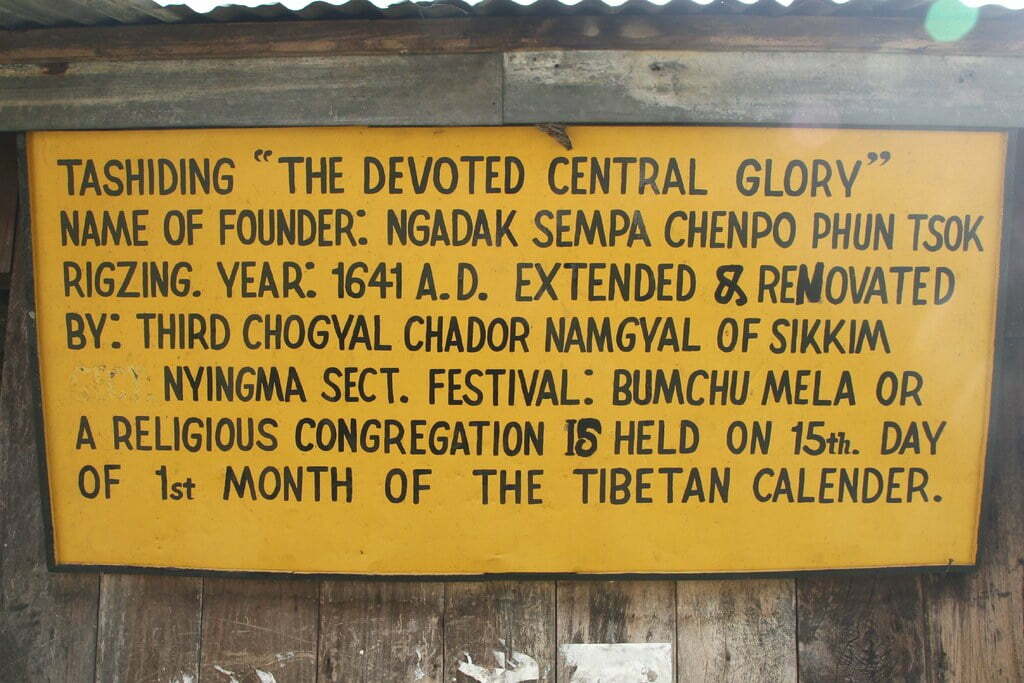Celebrated each year on the 15th day of the first month of the Lunar calendar corresponding to the month of February/March, the festival of Bumchu is among the most auspicious festivals in Sikkim celebrated in the Tashiding Monastery of west Sikkim which attracts devotees from all over Sikkim and neighbouring countries like Bhutan, Nepal, etc. The major highlight of the festival being the opening of the vessel containing the holy water, where the level of the water in the vessel is believed to be a sign of fortunes of the coming year. If the water level is higher or lower than it signifies ill fortune such as droughts, diseases and natural calamities. Each year, to verify the level of water in it, the vessel is opened conducting a special recitation before it is taken out of the case.

Once the vessel is opened, the monks of the monastery take seven cups of water from the Rathong Chu and mix it with holy water to be distributed among the devotees. Seven cups of water are taken from the Rathong Chu to refill the vessel again and put it into a vase and sealed until next year.
The festival of Bumchu has its own story. It is believed that among the four-patron saint of Sikkim, Nga-Dag Sempachenpo Phuntshok Rigzin was a pure descendent of 38th king of Tibet (Chogyal Dhri-Sung Deutsen) born from father Tashi Thitsen and mother Lha-Chig Sonam Dolma in the fifth day of fourth month of 10th Rabjung Water Male Dragon year (1592 AD). After excelling the Sutra, Mantra and Philosophical knowledge of Buddha Dharma from his grandfather Ngadak Takshamchen and many other teachers, he sat on strict meditation in essence-extraction for twelve years with simply ordinary clothes on and gained the siddhi of the highest form.
Once, after his completion of one hundred thousand prostrations (Kyang-chag) in Lhasa, the present capital of Tibet, he prayed Jho of Lhasa and Avaloketesharaya (Chenrezi) where miraculous rays were shifted from the heart of Avaloketesharaya towards his own. This sign of utter auspiciousness was witnessed by his escorts and many other followers. As per the prophecy made by the guru Padmasambhava in eight century A.D., Ngadag-Sampa-Chenpo took an oath to open a holy land of Bayul Dremazong, establish a Monastery and start a chanting session of hundred million mantras of Avaloketeshwara (Mani) and in the year 1642 (12th Rabjung Water Horse Year) he came to Bayul Dremazong.

At the age of 56 in the year 1646 A.D., Ngadag-Sempa-Chenpo, conducted the first hundred million recitation of Mani Mantra and the Dopchod of Tsasum-Thuje-Chenpo-Khorwa-Le-Drol of Terton (treasure revealer) Shigpo-Lingpa (1524-1583) at Lakhang Marpo at Yuksam which was also the first monastic center he had established after arriving in Bayul Dremazong.
Second recitation of hundred million Mani Mantras was conducted at Salam Rinchenpong in Tibet followed by the third recitation of similar numbers at Peytoe Karma Dolzom (a place in Tibet) and finally the fourth and fifth session of mani recitation of hundred million conducted at Tashiding where numerous sign of auspiciousness such as non-decaying, non-drying and fragrant smell aroused from the Bumchu. This significant sign of auspiciousness convinced him as a direct blessing of Avaloketesharaya. From there itself, the continuous session of puja of Thuji-Chenpo-Khorwa-Le-Drol taking place at Tashiding from the eight day of first month of Lunar Calendar.
Since then its last and final session of mani mantra recitation at Drakar Tashiding, this has been the 374 years of holy Bumchu ceremony being held till date i.e. March 17th and 18th 2022.
On the morning of fifteen day of first month of Lunar Calendar, the distribution of Holy Water and the audience of Holy Vase are being given for the devotees without any interruption so far. With the raise of extra cup of holy water in the year 2015 in front of the monks and the government representatives present, the doubts and the speculation regarding the sanctity of the Holy Bumchu are believed to be cleared once again.

